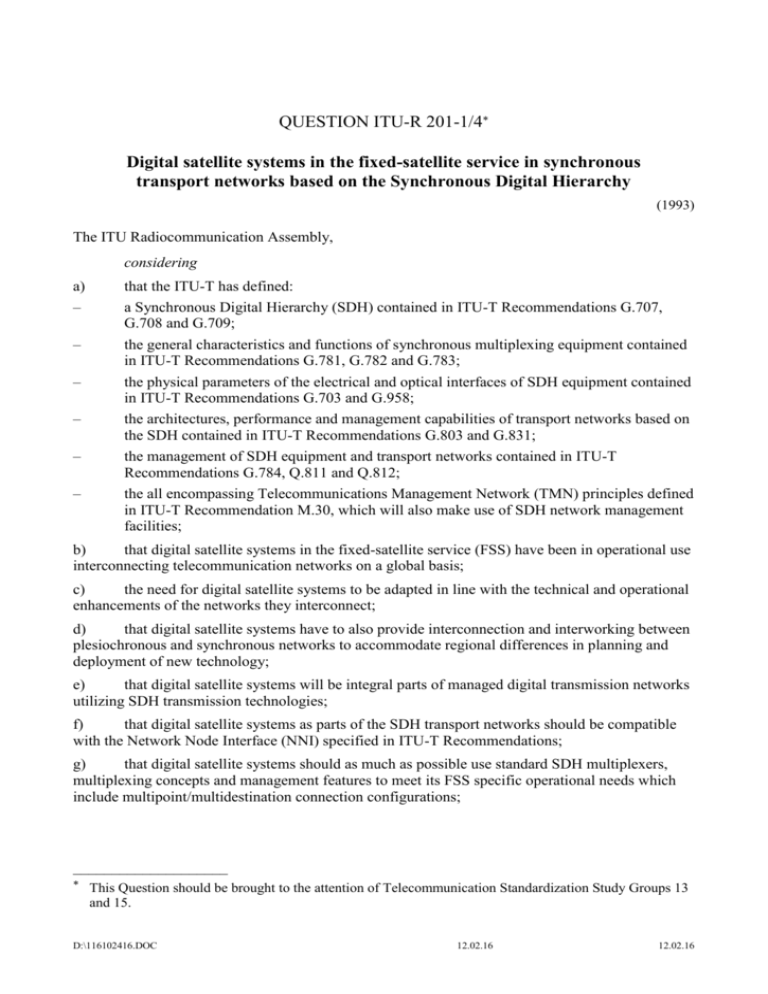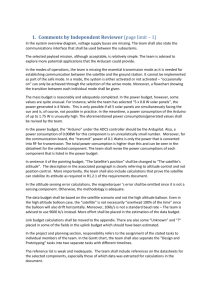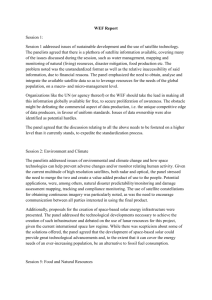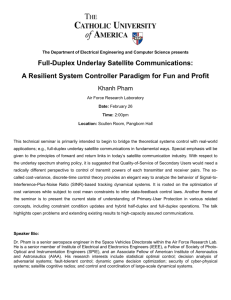Radiocommunication Study Groups
advertisement

QUESTION ITU-R 201-1/4* Digital satellite systems in the fixed-satellite service in synchronous transport networks based on the Synchronous Digital Hierarchy (1993) The ITU Radiocommunication Assembly, considering a) – – – – – – that the ITU-T has defined: a Synchronous Digital Hierarchy (SDH) contained in ITU-T Recommendations G.707, G.708 and G.709; the general characteristics and functions of synchronous multiplexing equipment contained in ITU-T Recommendations G.781, G.782 and G.783; the physical parameters of the electrical and optical interfaces of SDH equipment contained in ITU-T Recommendations G.703 and G.958; the architectures, performance and management capabilities of transport networks based on the SDH contained in ITU-T Recommendations G.803 and G.831; the management of SDH equipment and transport networks contained in ITU-T Recommendations G.784, Q.811 and Q.812; the all encompassing Telecommunications Management Network (TMN) principles defined in ITU-T Recommendation M.30, which will also make use of SDH network management facilities; b) that digital satellite systems in the fixed-satellite service (FSS) have been in operational use interconnecting telecommunication networks on a global basis; c) the need for digital satellite systems to be adapted in line with the technical and operational enhancements of the networks they interconnect; d) that digital satellite systems have to also provide interconnection and interworking between plesiochronous and synchronous networks to accommodate regional differences in planning and deployment of new technology; e) that digital satellite systems will be integral parts of managed digital transmission networks utilizing SDH transmission technologies; f) that digital satellite systems as parts of the SDH transport networks should be compatible with the Network Node Interface (NNI) specified in ITU-T Recommendations; g) that digital satellite systems should as much as possible use standard SDH multiplexers, multiplexing concepts and management features to meet its FSS specific operational needs which include multipoint/multidestination connection configurations; ____________________ * This Question should be brought to the attention of Telecommunication Standardization Study Groups 13 and 15. D:\116102416.DOC 12.02.16 12.02.16 -24/1-E h) that the use of SDH standard features in the design and for enhanced operation of satellite systems should be a trade-off with the continued need of efficient use of FSS spectrum and orbital resource utilization; j) that digital satellite systems for SDH traffic handling should be designed to provide adequate channel performance in order to comply with ITU-T Recommendation G.826; k) that the implications of the SDH concepts, functional requirements and characteristics on satellite systems have to be analyzed, and incompatibilities with satellite long transmission delay and Doppler effects be either removed or compensated for, decides that the following Question should be studied 1 What are the most appropriate, from radio resource and spectrum efficiency viewpoint, digital satellite system internal network architectures as subnetworks or network functional elements in an SDH-based transport networks? 2 – – – What satellite subnetwork “modem” interworking functionality are required: to permit point-to-point and multidestination operation within the subnetwork; to match the satellite non-hierarchical section layers to the anticipated satellite route size; to accommodate in the section overhead media specific functions? 3 What are the system requirements in terms of network synchronization, timing distribution, buffer requirements to ensure proper integration in SDH-based transport networks? 4 Within the broader SDH transport networks, what are the FSS-SDH subnetwork specific needs in terms of network management and operations administration and maintenance (OAM), which should be satisfied using standard SDH facilities (e.g. for enhanced operation, configuration control, traffic handling including multipoint networking, performance monitoring)? 5 Which SDH standard protocols or part thereof need to be identified and possibly adapted for proper operation over satellite links with the inherent satellite propagation delay? 6 What functional requirements for FSS-SDH terrestrial digital interface equipment need to be satisfied using standard functions of SDH multiplex equipment and interfaces, including means and interfaces for accommodating the future TMN, and what modifications to these standards are necessary when used for FSS-SDH? 7 What are the satellite transmission system specific functional requirements which are to be accommodated in suitable satellite frame overhead capacity and functions? 8 What are the transmission characteristics of satellite links in these SDH subnetworks to ensure conformance with relevant ITU-T performance requirements, to ensure unimpaired operation of the standard digital functions of the SDH multiplex and transport, and to achieve an efficient utilization of satellite radio frequency and orbital locations? further decides 1 that the results of these studies should lead to the formulation of appropriate Recommendations by 2006. NOTE 1 – See Recommendations ITU-R S.1149, ITU-R S.1250, ITU-R S.1251 and ITU-R S.1252. _____________ D:\116102416.DOC 12.02.16 12.02.16








